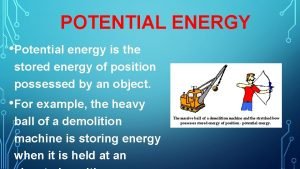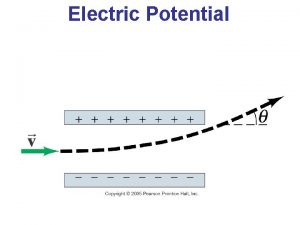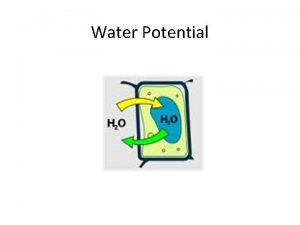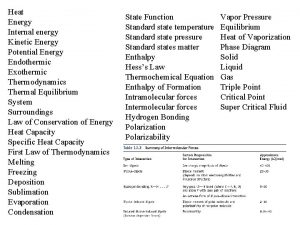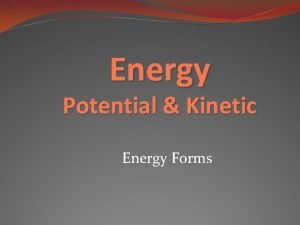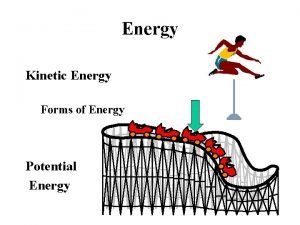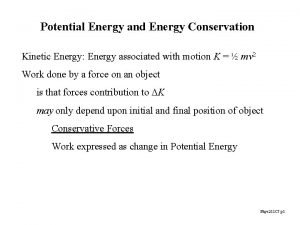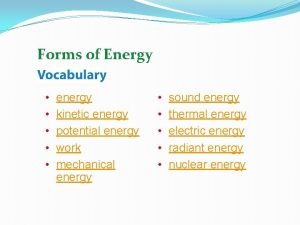Potential Energy n Potential energy is associated with



















- Slides: 19

Potential Energy n Potential energy is associated with the position of the object within some system n n Potential energy is a property of the system, not the object A system is a collection of objects interacting via forces or processes that are internal to the system

Work and Potential Energy n n For every conservative force a potential energy function can be found Evaluating the difference of the function at any two points in an object’s path gives the negative of the work done by the force between those two points

Gravitational Potential Energy n Gravitational Potential Energy is the energy associated with the relative position of an object in space near the Earth’s surface n n Objects interact with the earth through the gravitational force Actually the potential energy is for the earth-object system

Work and Gravitational Potential Energy n PE = mgy n n Units of Potential Energy are the same as those of Work and Kinetic Energy

Work-Energy Theorem, Extended n n The work-energy theorem can be extended to include potential energy: If other conservative forces are present, potential energy functions can be developed for them and their change in that potential energy added to the right side of the equation

Reference Levels for Gravitational Potential Energy n A location where the gravitational potential energy is zero must be chosen for each problem n The choice is arbitrary since the change in the potential energy is the important quantity

n Choose a convenient location for the zero reference height n n n often the Earth’s surface may be some other point suggested by the problem Once the position is chosen, it must remain fixed for the entire problem Note the different possible reference levels for the book in the diagram at the right. The desktop, the floor or the ground outside the building may be used as a reference level depending on the problem under consideration.


Conservation of Mechanical Energy n Conservation in general n n To say a physical quantity is conserved is to say that the numerical value of the quantity remains constant throughout any physical process In Conservation of Energy, the total mechanical energy remains constant n In any isolated system of objects interacting only through conservative forces, the total mechanical energy of the system remains constant.

Conservation of Energy, cont. n Total mechanical energy is the sum of the kinetic and potential energies in the system n Other types of potential energy functions can be added to modify this equation



Problem Solving with Conservation of Energy n n Define the system Select the location of zero gravitational potential energy n n Do not change this location while solving the problem Identify two points the object of interest moves between n n One point should be where information is given The other point should be where you want to find out something

Problem Solving, cont n n Verify that only conservative forces are present Apply the conservation of energy equation to the system n n Immediately substitute zero values, then do the algebra before substituting the other values Solve for the unknown(s)

Work-Energy With Nonconservative Forces n n If nonconservative forces are present, then the full Work-Energy Theorem must be used instead of the equation for Conservation of Energy Often techniques from previous chapters will need to be employed

Example 5. 5: A diver of mass m drops from a board 10. 0 m above the water’s surface, as in the diagram. Neglect air resistance. a. Use conservation of mechanical energy to find his speed 5. 00 m above the water’s surface. b. Find his speed as he hits the water.

Example 5. 6 A powerful grasshopper launches itself at an angle of 45° above the horizontal and rises to a maximum height of 1. 00 m during the leap. With what speed vi did it leave the ground? Neglect air resistance.

Example 5. 7: Waterslides are nearly frictionless, hence can provide bored students with high-speed thrills. One such slide, Der Stuka, named for the terrifying German dive bombers of World War II, is 72. 0 feet high (21. 9 m), found at Six Flags in Arlington, Texas. a. Determine the speed of a 60. 0 kg woman at the bottom of such a slide, assuming no friction is present. b. If the woman is clocked at 18. 0 m/s at the bottom of the slide, how much mechanical energy was lost through friction?

 Volts to ev
Volts to ev Electric potential from electric field
Electric potential from electric field Electric potential and potential energy
Electric potential and potential energy Power equation
Power equation Gravity and kinetic energy
Gravity and kinetic energy Chemical energy
Chemical energy What is energy
What is energy Gravitational potential energy vs kinetic energy
Gravitational potential energy vs kinetic energy Potential vs kinetic energy
Potential vs kinetic energy Potential energy examples
Potential energy examples The change in mechanical energy
The change in mechanical energy Gravitational potential energy
Gravitational potential energy Formula of potential energy
Formula of potential energy Why is water potential measured in pascals
Why is water potential measured in pascals How does water potential affect osmosis
How does water potential affect osmosis How to calculate solute potential
How to calculate solute potential Neuronal pool
Neuronal pool Graded potential
Graded potential Action potential
Action potential Graded potential vs action potential
Graded potential vs action potential




























